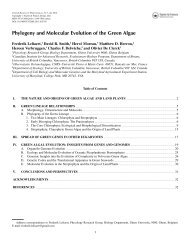Phylogeny and molecular evolution of green algae - Phycology ...
Phylogeny and molecular evolution of green algae - Phycology ...
Phylogeny and molecular evolution of green algae - Phycology ...
You also want an ePaper? Increase the reach of your titles
YUMPU automatically turns print PDFs into web optimized ePapers that Google loves.
24 CHAPTER 2<br />
the UTC clades <strong>and</strong> the coinciding ecological diversification was rapid. Even with a liberal estimate <strong>of</strong><br />
the Streptophyta-Chlorophyta split set at 1200 My (Herron et al. 2009), the UTC radiation would have<br />
occurred in ca. 20 to 30 million years (unpublished results), complicating interpretation <strong>of</strong> the<br />
ecological diversification.<br />
The relationships between the Ulvophyceae, Trebouxiophyceae <strong>and</strong> Chlorophyceae have not been<br />
unambiguously resolved up until now. Phylogenies based on SSU nrDNA sequences have been<br />
inconclusive, with the branching order <strong>of</strong> the UTC classes depending on taxon sampling, alignment<br />
methods <strong>and</strong> phylogenetic techniques (Fig. 1). Some early SSU phylogenies showed a sister<br />
relationship between Chlorophyceae <strong>and</strong> Trebouxiophyceae (Friedl 1995, Bhattacharya et al. 1996,<br />
Krienitz et al. 2001, Lopez-Bautista <strong>and</strong> Chapman 2003) while others revealed a sister relation<br />
between the Chlorophyceae <strong>and</strong> Ulvophyceae (Friedl <strong>and</strong> O'Kelly 2002, Lewis <strong>and</strong> Lewis 2005,<br />
Watanabe <strong>and</strong> Nakayama 2007). Although chloroplast phylogenomics has been valuable to resolve<br />
problematic relationships among <strong>green</strong> <strong>algae</strong> (Qiu et al. 2006, Jansen et al. 2007, Lemieux et al. 2007,<br />
Turmel et al. 2008, Turmel et al. 2009), it has not been able to resolve the branching order <strong>of</strong> the UTC<br />
classes conclusively. Whereas phylogenetic analysis <strong>of</strong> 58 concatenated chloroplast genes supported<br />
a sister relation between Ulvophyceae <strong>and</strong> Trebouxiophyceae, chloroplast gene order data <strong>and</strong><br />
genome structure (gene losses <strong>and</strong> rearrangements within conserved gene clusters), as well as a<br />
phylogenetic analysis <strong>of</strong> seven mitochondrial genes supported a sister relationship between<br />
Ulvophyceae <strong>and</strong> Chlorophyceae (Pombert et al. 2004, Pombert et al. 2005).<br />
Ultrastructural evidence has been interpreted as either providing support for a sister relation<br />
between Chlorophyceae <strong>and</strong> Trebouxiophyceae (Mattox <strong>and</strong> Stewart 1984) or between<br />
Trebouxiophyceae <strong>and</strong> Ulvophyceae (Sluiman 1989) based on the shared presence <strong>of</strong> a phycoplast<br />
<strong>and</strong> a non-persistent mitotic spindle in the first case <strong>and</strong> a counterclockwise orientation <strong>of</strong> the<br />
flagellar basal bodies in the second case (Fig 1). Our phylogeny suggests an alternative branching<br />
order that necessitates reinterpretation <strong>of</strong> the <strong>evolution</strong> <strong>of</strong> ultrastructural features. It now appears<br />
more likely that the ancestor <strong>of</strong> the UTC clade had a phycoplast <strong>and</strong> a non-persistent mitotic spindle,<br />
<strong>and</strong> that both characters have been lost in the Ulvophyceae. The ancestral status <strong>of</strong> a phycoplast <strong>and</strong><br />
a non-persistent mitotic spindle is congruent with the presence <strong>of</strong> these features in the<br />
Chlorodendrales (e.g. Tetraselmis), the closest prasinophyte relatives <strong>of</strong> the UTC clade (Mattox <strong>and</strong><br />
Stewart 1984). Likewise the ancestor <strong>of</strong> the UTC clade probably had a counterclockwise orientation<br />
<strong>of</strong> the flagellar basal bodies, evolving to a direct opposite or clockwise orientation in the<br />
Chlorophyceae. Again this interpretation is congruent with the presence <strong>of</strong> a counterclockwise basal<br />
body orientation in Tetraselmis. The modern UTC clade appeared after that a new mode <strong>of</strong> cell<br />
division, which is mediated by a phycoplast <strong>and</strong> enables complex multicellular growth, was<br />
introduced in the marine ancestor <strong>of</strong> the UTC clade. The following ecophysiological adaptations lead<br />
to the success <strong>of</strong> the Chlorophyceae <strong>and</strong> Trebouxiophyceae in freshwater habitats (Becker <strong>and</strong> Marin<br />
2009).

















